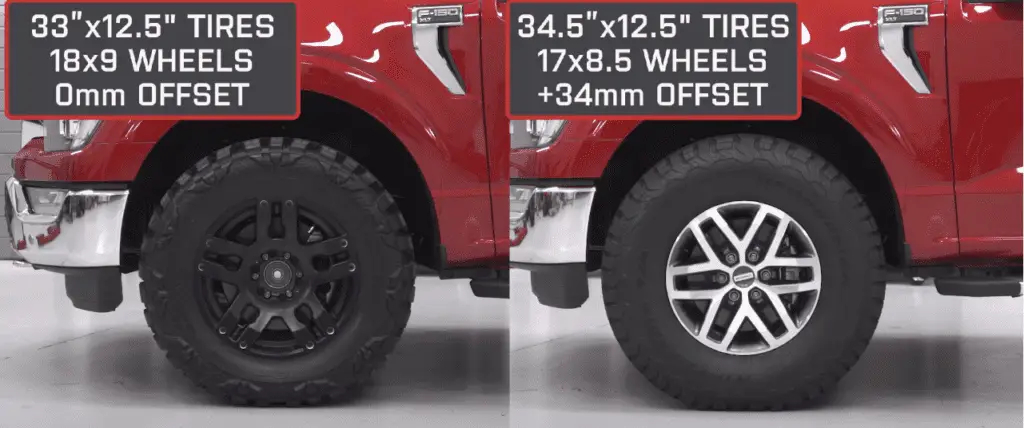Ford is a successful company known for its monstrous trucks and innovatively manufactured cars and vehicles. As you may know, cars come with different tires, varying in width and size, with or without removing the crash bars. Hence, if you own a Ford Stock F150 and want to educate yourself on the factor, you are looking in the right place! This article will hopefully answer every question you have! Keep on reading and get to know more about F150 tires!

Will 33s Fit On Stock F150?
Depending on whether your car’s rim is 10 inches or greater, a 33-inch tire can comfortably fit in your Ford Stock F150 without removing or bending the crash bars.
According to the technical experts in this field, the most significant tire size that could fit in your Ford Stock F150 ranges between 33 and 34 inches. They do not involve any bending or removal of crash bars. The state honestly depends on your Ford’s rim size. If your car’s rim size is above or is 10 inches, then a 33-inch tire size would fit easily on your Stock F150.
How Big Of Tires Can I Fit On My F150?
Ford’s Stock F150 is a large vehicle that can stay rooted over 33 to 34 inches tires while keeping the crash bars in their place. After removing the crash bars, you can also fit 35 to 37 inches of tires in your Ford Stock F150.
Vehicle tires’ sizes and widths vary according to which type of car you use, whether a truck or a common four-wheeler. As per the developers and the experts on the topic, the biggest and the widest tires that could easily fit in your Ford Stock F150 are those with a width of 33 and 34 inches without removing crash bars. On the other hand, you can ceaselessly fit tires of 35 to 37 inches after removing the crash bars. Big tires offer sturdier driving over off-lanes and rocky paths. However, it is to be noted that the bigger the tire is, the louder your drive is because big tires tend to be noisier than smaller tires.
How Wide Are Stock F150 20-Inch Rims?
A Ford’s Stock F150’s 20-inch rims are reportedly 8.5 inches wide.
As you may know, rims are as vital as any other wheel accessory. Rims frame the whole wheel structure and keep drives sturdier on unsteady pathways and roads. That said, the wideness of more giant rims is in question, such as how wide the 20-inch rims are. To answer your concern straightforwardly and directly, a 20-inch rim is stated to be 8.5 inches wide, supplying sturdiness to the wheel and the whole car.
What Is The Biggest Tire For A 20-inch Rim?
A rim of the Ford Stock F150, as wide as 20 inches, can allow a 37-inch-wider to fit perfectly and suitably.
In light of the above, a rim with a dimension of 20 inches can hold a wider range of enormous tires, which are thicker and more expansive. According to the resources gathered for this article’s supplement, a 2-inch-wide tire can safely hold a tire as big as 37 inches without severe rubbing, bending, or removal of crash bars or any other feature in the wheel.
What Size Tires Will Fit My Ford F150?
Different tires of numerous sizes can fit into your Stock F150. These tire sizes range from the standard 245/70 R17 to the ultimately huge 275-45-22. The sizes and their fitness also depend greatly on the rim size.
The article states that numerous tires with different sizes, widths, and dimensions can fit in your Ford Stock f150. Likewise, the sizes of tires differ as the rim size differs. The standard tire size for an 18-inch wide rim is 265-60-18 and 275-65-18. At the same time, the rim consisting of a 20-inch size can fit a tire size of 275-55-20. Lastly, a, aa nch wide rim is suitable for fitting a tire comprising 275-45-22. Generally speaking, the most common and usual rim for any Stock F150 is a 17-inch wide rim, which can easily fit a 245/70 R17 size tire.
What Is The Lug Spacing For A Ford Wheel?
Lug spacing or bolt patterns are the make-believe circles that line your car’s wheels. They suggest a specific arrangement of the patterns encircling the wheel.
The diameter of an imaginary circle produced by the centers of the wheel lugs is known as the bolt pattern, lug spacing, lug pattern, or bolt circle. Bolt patterns with 4, 5, 6, or 8 lug holes are available in your Ford Stock F150. A bolt circle of 4×100 indicates a four-lug arrangement on a 100mm-diameter circular. The bolt pattern comprises two numbers: the first is the number of bolt holes on the wheel, and the second is the distance between them. A 5-115mm bolt pattern means the wheel has five bolt holes that are 115mm apart as measured across the center of the wheel.
Can You Fit Bigger Tires On Stock Rims?
Yes, you can fit tires bigger than the standard size of your stock F150 rims. You can go as much as 20 millimeters on a rim that has the standard width size.
When making tight turns or when the suspension bottoms out, the tires may rub against the fender well if the replacement wheels and tires are more significant than the originals. As speedometers estimate speed by measuring the distance covered for each wheel spin, a change in size can result in an incorrect result. The wheels’ and tires’ factory diameter and width must be maintained to keep the suspension and speedometer working correctly. To do so, bigger tires are required; in that case, on the original rim, you can put a tire up to 20 millimeters wider than standard. The rim width will determine the actual width of the tire: For every half-inch, which is 12.5 millimeters, increase in rim width, the tire will expand 5 millimeters.
How Long Do Stock F150 Tires Last?
Ford’s Stock F150’s tires can last until after 50 thousand miles of running time, after which it is recommended to change the respective tires immediately before they cause any hazardous issues.
After educating yourself on the facts above, you must wonder how long these Ford Stock F150 tires last if they are so extensive and comprehensive in their respective dimensions. To clarify your doubts and concerns, it is reportedly stated that a Stock F150’s tires can run up to 50 thousand miles before showing symptoms of dying out. For tires this large and wide, it is evident that they can run for more than one thousand miles.
Will 20×10 Fit F150?
Due to the spaciousness of the front and rear and the’s standard due to the spaciousness of the front and rear and the tire’s standard size, a 20×10 tire can be placed on the rims of your Ford Stock F150 quite simply and without any effort.
According to the online source, stock F150 users suggest and prove that 20×10 tires can ceaselessly fit into the vehicle without using a leveling kit. In the case of crash bars, there is no requirement for rubbing or trimming because these tires tend to fit perfectly in the car’s rims.
How Big Of A Lift Do I Need For 37-Inch Tires?
To lift a 37-inch-wide Stock F150 tire, you need a lifting kit that is 3.5 inches or bigger.
To lift and change a tire of your Ford Stock F150, you need a suitable lifting kit to lift your car’s wheels or tires with sustainability and no hardships or issues. In the case of a tire that is as wide as 37 inches, it is recommended that you use a 3.5-inch lifting kit or more to compensate for the tire’s weight and width.
Will Bigger Tires Raise My Truck?
If you plan to install bigger tires in your Stock F150, it will surely raise the truck due to its vastness and extensive width.
Bigger tires will surely raise the height of your Ford Stock F150. Bigger tires raise a truck higher, allowing for more ground clearance and a greater wheelbase rate.
Do Wider Tires Ride Better?
Wide tires have a more significant performance rate and result than any other tire because of their spacious stability and ability to be driven over any lane, whether rocky, smooth, or muddy.
Wide tires indeed show better performance than thin tires, as they level up with the surface of the ground more evidently than the latter. For nonporous surfaces and high-performance vehicles, bigger tires are preferable. A larger surface area allows for increased traction and durability daily. Any car with larger wheels has a stiffer ride quality. They do, however, significantly improve stability and handling. There are options for obtaining a smooth ride and good stability and handling.
Do Wider Tires Decrease Gas Mileage?
On an unluckier note, the wide tires of Stock F150 tend to decrease the vehicle’s gas mileage due to their massiveness and fuel consumption rate spin.
Even though this article supports the utilization of wide and oversized tires, it is unfortunate that wide tires consume more fuel and reportedly decrease a car’s gas mileage. This decrease is due to the large tires’ weight and heaviness. Small tires increase fuel efficiency, while large tires decrease the gas mileage rate of your car.
Do Bigger Rims Affect Ride Quality?
According to those mentioned above, more giant rims indeed promise better performance than any other rims due to the rate of their stability and authentic performance while the car is driving.
In light of the above, if your car is installed with more giant rims, it will positively affect the ride quality. A steadier drive without any bumpiness or mishap would result from placing more giant rims. Giant rims make the ride stiffer, providing stability and handling quite profoundly.
Does Changing Tire Size Affect Transmission?
Yes, changing the tires of your car does affect the transmission as the weight grows. As a result, the wheels move slower than their original speed as they require more power to accelerate.
If you recently changed your Stock F150 tires and noticed some irregular transmission shift, it is because the tire change dramatically affects your car’s transmission rate. As the size grows, the gear ratio becomes a problem. The tires rotate slower when the size increases, yet the ground covered remains the same. Acceleration requires more power, just like a muscle in the body needs more energy. As a result, the current gear ratio is put under a lot of pressure, affecting the vehicle’s transmission.
The tire business is quite vast if you look into it. Selecting appropriate tires for your Stock F150 truck can become complicated, but after reading and fully understanding this article, you would quickly compensate your truck knowingly and profoundly. In a nutshell, Ford’s trucks tend to be less burdensome, allowing a promising performance by their wheels and the whole car overall.
